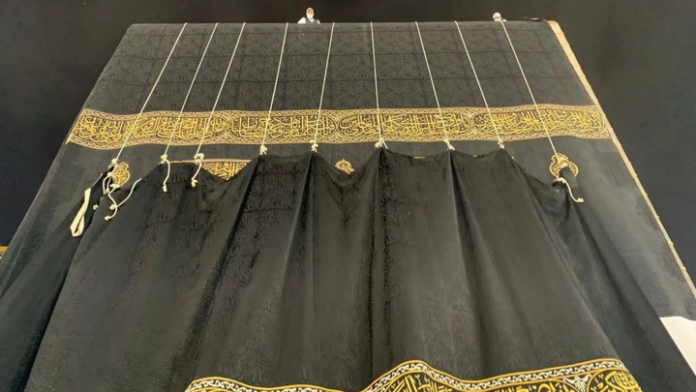An age-old tradition continues with precision and reverence in Makkah
Makkah — On the first day of the Islamic New Year, Saudi Arabia unveiled the new Kiswa, the richly adorned black cloth that envelops the Kaaba, marking a sacred tradition that dates back to the era of Prophet Muhammad ﷺ, reported the Al Arabiya News.
Crafted from 670 kilograms of natural black silk and adorned with 150 kilograms of gold and silver-plated threads, the new Kiswa showcases 68 Qur’anic verses meticulously embroidered with 24-karat gold-plated silver. The stitching, entirely hand-done, reflects the mastery of skilled artisans who continue the heritage using traditional Islamic embroidery techniques.
Spanning an area of 658 square meters and comprising 47 silk panels, the Kiswa weighs over a metric ton. It is produced annually at the King Abdulaziz Complex for the Manufacturing of the Kaaba’s Kiswa in Makkah, with a reported cost of approximately $4.5 million (SAR 17 million).
The installation of the new Kiswa takes place every year on the 1st of Muharram, the first day of the Islamic lunar calendar. The process involves over 100 specially trained technicians and is conducted with utmost care to ensure the Kaaba remains respectfully covered at all times. Electric lifts and scaffolding aid in the seamless draping of the new covering.
To protect the Kiswa during the days of Hajj—when millions of pilgrims gather and touch the Kaaba—a white cotton cover, known as the “Ihram of the Kaaba,” is temporarily affixed to the lower part of the cloth. This precaution prevents it from being torn, soiled, or damaged during the rituals.
Following the replacement, the old Kiswa is carefully removed, cleaned, and cut into around 56 pieces. These pieces are then distributed as gifts under royal directives to Muslim heads of state, ambassadors, major Islamic institutions, and international organizations. The remaining fragments are preserved in Saudi archives and government conservation centers.
These pieces are regarded as invaluable artifacts of spiritual and cultural heritage. Some are publicly displayed in museums, exhibitions, and religious institutions across the world.
The tradition of draping the Kaaba has evolved through Islamic history. In the time of Prophet Muhammad ﷺ, the Kaaba was covered with Yemeni cloth. During subsequent Islamic dynasties, particularly under the Mamluks and Ottomans, Kiswas were produced in Egypt and sent to Makkah in ceremonial caravans.
Since 1927, following a decree by King Abdulaziz, Saudi Arabia began the local production of the Kiswa. Today, hundreds of craftsmen at the King Abdulaziz Complex manage every stage—from dyeing and weaving silk to the precise gold and silver embroidery of the Qur’anic verses.
Some of the earliest known Kiswa fragments, dating back to the Mamluk era of 1517, are preserved in institutions such as the Grand Mosque of Bursa in Turkey, Cairo’s Islamic museums, and Turkish archival collections—serving as timeless reminders of Islamic artistry and devotion.




